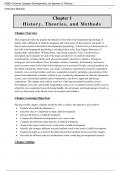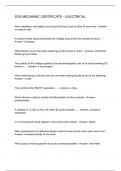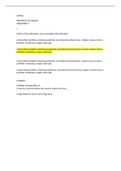(HDEV (Human Lifespan Development), 5e Spencer A. Rathus )
(Instructor Manual) 1
Chapter 1
History, Theories, and Methods
Chapter Overview
This chapter provides the general introduction to the field of developmental psychology. It
begins with a definition of child development and a discussion of the purposes and goals of
theory and research in the field of developmental psychology. A brief survey of the pioneers in
the field of developmental psychology, including John Locke, Jean-Jacques Rousseau, G.
Stanley Hall, Alfred Binet, William Perry, and Gisella Labouvie-Vief, is followed by a
description and evaluation of each of the major perspectives on child development—
psychoanalytic, learning (behavioral and social cognitive theories), cognitive, biological,
ecological, and sociocultural. Next, the nature–nurture, continuity–discontinuity, and active–
passive controversies in the field of development are overviewed. Finally, research methods are
described (naturalistic-observation, case study, correlation, experimental research, longitudinal
research, cross-sectional studies, and cross-sequential research), including a presentation of the
general idea behind the scientific method, ways of gathering information in child developmental
science, the correlational method (and its limitations), and how to approach and design
experiments. The chapter ends with an overview of the special methods needed to assess
development over time, specifically longitudinal versus cross-sectional research and the ways in
which the cross-sequential research design handles the advantages and disadvantages of each, as
well as a discussion of the ethical issues in research with children.
Chapter Learning Objectives
Having read the chapter, students should be able to achieve the objectives given below.
• Explain what child development is
• Describe why it is important to study child development
• Discuss the history of child development
• Compare the different developmental views across time
• Compare the different major theories of child development
• Analyze the major controversies in the study of child development
• Identify and compare different research methods used in the study of child development
• Explain the purpose of each of the different research methods discussed in this chapter
• Describe the different ethical considerations when conducting developmental research
Chapter Outline
© 2018 Cengage Learning. All Rights Reserved. May not be scanned, copied or duplicated, or posted to a publicly accessible website, in whole or in part.
, 2
I. The Development of the Study of Human Development
• Developmental psychology is the discipline that studies the physical, cognitive, social,
and emotional development of humans.
• In ancient times and in the Middle Ages, children often were viewed as innately evil and
discipline was harsh.
• English philosopher John Locke (1632–1704) believed that the child came into the world
as a tabula rasa—a “blank tablet” or clean slate—that was written on by experience.
• Jean-Jacques Rousseau (1712–1778), a Swiss-French philosopher, argued that children are
inherently good and that, if allowed to express their natural impulses, they will develop
into generous and moral individuals.
• G. Stanley Hall (1844–1924) is credited with founding child development as an academic
discipline and bringing scientific attention to focus on the period of adolescence.
• French psychologist Alfred Binet (1857–1911), along with Theodore Simon (1872–1961),
developed the first standardized intelligence test near the beginning of the 20th century.
• In the 20th century, psychologists began to take on a life-span perspective, in which they
viewed human development as occurring throughout the individual’s lifetime.
o William Perry and Gisella Labouvie-Vief, for example, have studied the
development of cognitive complexity from adolescence to late adulthood.
o K. W. Schaie and others have studied trends in various mental abilities throughout
middle and late adulthood, showing that some abilities decline in middle and late
adulthood, but others that represent the accumulation of decades of knowledge can
advance into late adulthood.
II. Theories of Development
• John B. Watson (1878–1958), the founder of American behaviorism, viewed development
in terms of learning theory.
o He generally agreed with John Locke that children’s ideas, preferences, and skills are
shaped by experience.
• Arnold Gesell expressed the opposing idea that biological maturation—the unfolding of
genetically determined traits, structures, and functions—was the main principal of
development.
A. The Psychoanalytic Perspective
• A number of theories fall within the psychoanalytic perspective.
o Each owes its origin to Sigmund Freud and views children—and adults—as
caught in conflict.
, 3
• The expression of basic drives, such as sex and aggression, conflict with parental
expectations, social rules, moral codes, even laws.
o But the external limits—parental demands and social rules—are brought inside or
internalized.
o Once internalization occurs, the conflict takes place between opposing inner
forces.
• Freud’s theory of psychosexual development and Erik Erickson’s theory of
psychosocial development are stage theories that see children developing through
distinct periods of life.
o Each suggests that the child’s experiences during early stages affect the child’s
emotional and social life at the time and later on.
Sigmund Freud’s Theory of Psychosexual Development
• Sigmund Freud’s (1856–1939) theory of psychosexual development focused on the
following three parts of the personality.
o Id: It is present at birth and is unconscious.
▪ It represents biological drives and demands instant gratification, as
suggested by a baby’s wailing.
o Ego: It curbs the appetites of the id and makes plans that are in keeping with
social conventions so that a person can find gratification but avoid social
disapproval.
o Superego: It develops throughout infancy and early childhood.
▪ It brings inward the wishes and morals of the child’s caregivers and other
members of the community.
• According to Freud, the following are the five stages of psychosexual development.
o Oral stage: During the first year of life, “oral” activities such as sucking and
biting bring pleasure and gratification.
o Anal stage: During this stage, gratification is obtained through control and
elimination of waste products.
o Phallic stage: During this stage, parent–child conflict may develop over
masturbation, which many parents treat with punishment and threats.
o Latency stage: By age five or six, Freud believed, children enter this stage
during which sexual feelings remain unconscious, children turn to schoolwork,
and they typically prefer playmates of their own sex.
o Genital stage: The final stage of psychosexual development begins with the
biological changes that usher in adolescence.
▪ Adolescents generally desire sexual gratification through intercourse with
a member of the other sex.
, 4
Evaluation
• Freud’s views about the anal stage have influenced child-care workers to
recommend that toilet training not be started too early or handled punitively.
o His emphasis on the emotional needs of children has influenced educators to
be more sensitive to the possible emotional reasons behind a child’s
misbehavior.
• Freud’s work has also been criticized.
o For one thing, Freud developed his theory on the basis of contacts with adult
patients (mostly women) (Hergenhahn & Henley, 2014), rather than
observing children directly.
o Some of Freud’s own disciples, including Erik Erikson, believe that Freud
placed too much emphasis on basic instincts and unconscious motives.
Erik Erikson’s Theory of Psychosocial Development
• Erik Erikson (1902–1994) modified Freud’s theory and extended it through the adult
years.
o Erikson’s theory, like Freud’s, focuses on the development of the emotional
life and psychological traits, but Erikson focuses on social relationships rather
than sexual or aggressive instincts.
o Therefore, Erikson speaks of psychosocial development rather than of
psychosexual development.
o Furthermore, Erikson places greater emphasis on the ego, or the sense of self.
• Erikson (1963) extended Freud’s five stages to eight to include the concerns of
adulthood.
o Rather than label his stages after parts of the body, Erikson labeled them after
the life crisis—an internal conflict that attends each stage of psychosocial
development—that people might encounter during that stage.
• Early experiences affect future developments.
o Successful resolution of each crisis bolsters children’s sense of identity—of
who they are and what they stand for—and their future expectation of future
success.
• Erikson’s views, like Freud’s, have influenced child rearing, early childhood
education, and child therapy.
o For example, Erikson’s views about an adolescent identity crisis—a period of
inner conflict during which one examines one’s values and makes decisions
about one’s life roles—have entered the popular culture and have affected the
way many parents and teachers deal with teenagers.






